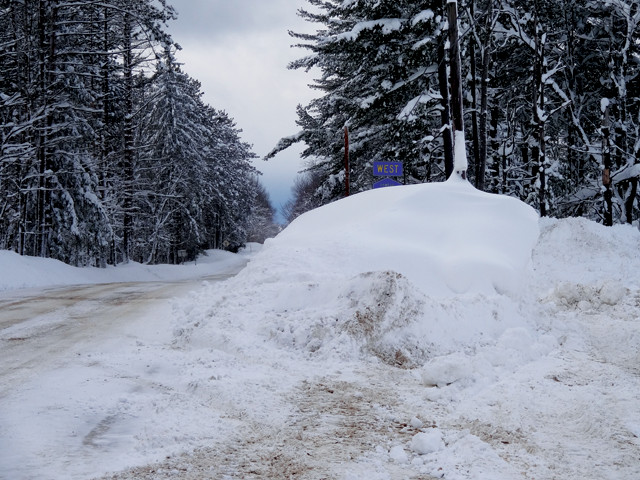
by Adityarup "Rup" Chakravorty Tuesday, February 27, 2018

The Tug Hill region east of Lake Ontario in Upstate New York is one of the most snow-prone areas in the U.S. as a result of lake-effect snow systems that blow in from the west. Credit: University of Utah.
On Dec. 11, 2013, Upstate New York’s Tug Hill region received more than 100 centimeters of snow in 24 hours. And annually, the region, which covers more than 5,000 square kilometers to the east of Lake Ontario, can see up to five times that amount. In comparison, Toronto, on the northwestern coast of the lake, averages less than 125 centimeters of snow each year.
This dramatic difference in winter snowfall totals is caused by lake-effect weather systems — intense bands of precipitation that form when cold air from the north and west flows east and south over the relatively warmer waters of Lake Ontario.
Several factors — including temperature differences between the atmosphere and the lake, and topographic features of the surrounding areas — are known to modulate lake-effect snow. A new study in the journal Monthly Weather Review adds another variable to the wintry mix, suggesting that the shape of Lake Ontario’s coastline may also play a role in determining which areas are most affected by lake-effect snow and how much precipitation falls.
Using data collected by the Ontario Winter Lake-effect Systems (OWLeS) field campaign during the Dec. 11, 2013, snowfall event, Jim Steenburgh, an atmospheric scientist at the University of Utah and lead author of the new study, and his colleague Leah Campbell modeled how shoreline geometry influenced this weather event.
The simulations were carried out with the Weather Research and Forecasting (WRF) Model, a weather prediction model that allowed the researchers “to examine the influences of several processes [on lake-effect precipitation] simultaneously,” says David Kristovich, a climate scientist at the University of Illinois at Urbana-Champaign, who was not involved in the study but was part of the OWLeS project.
That’s important because “the locations and intensity of lake-effect snows hitting the eastern and southern shores of Lake Ontario are determined by many processes that occur over the lake and even over land,” Kristovich says.
Over Lake Ontario, the prevailing west-to-east air flow meets breezes coming from the lakeshore onto the lake. These convergence zones occur fairly low in the atmosphere, so the air has no place to go but up. And as the air — laden with moisture and warmed by the lake — rises, it cools and condenses, forming clouds, which ultimately become saturated and lead to lake-effect precipitation at Tug Hill and other areas, predominantly to the east and south.
“Traditional thinking has been that temperature differences [between Lake Ontario and surrounding air masses] drive land breezes that converge near the center of the lake with the prevailing westerly air flow and lead to the formation of bands of snow,” Steenburgh says. “We found that it’s more complicated: Shoreline geometry affects where these convergence zones form, how strong they are, and, ultimately, where lake-effect snows impact the shoreline.”
Steenburgh and Campbell found three features of shoreline shape that influenced lake-effect snow bands over Lake Ontario: a gentle coastline bulge extending from about Niagara Falls to Rochester, N.Y., along the lake’s southwestern coast; another bulge along the lake’s southeastern coast near Tug Hill; and a peninsula on the lake’s northeastern coast near Point Petre in Ontario, Canada.
The bulge on the southwestern coast “plays a primary role in determining where the lake-effect system forms and where it goes,” Steenburgh says. In an accompanying study, Steenburgh and colleagues found that the bulge along the southeastern coast also played an important role in enhancing lake-effect snow. The peninsula near Point Petre, meanwhile, has a weaker and more intermittent effect.
In addition to lakeshore shape, the researchers also confirmed that differences in friction as air flows over Lake Ontario versus the surrounding coastlines affected air flows — slowing down air flow, leading to stagnation and the dumping of snow — and, in turn, lake-effect snows in the simulations they ran.
“The care taken to accurately describe the water and land area characteristics [in these studies] allows for building a more complete understanding of the atmospheric responses to the real environment,” Kristovich says.
Beyond the Great Lakes, lake-effect snows affect other areas as well, such as around Utah’s Great Salt Lake and along the southern coast of the Caspian Sea in Iran. And similar phenomena occur in maritime areas as well, leading to sea-effect or ocean-effect snows around the Black Sea, the North Sea, and the Sea of Japan, for instance.
“Many bodies of water around the world have complex coastline shapes,” Steenburgh says. “Recognizing the importance of coastline geometry can help us better understand — and predict — the weather systems in those areas.”
© 2008-2021. All rights reserved. Any copying, redistribution or retransmission of any of the contents of this service without the expressed written permission of the American Geosciences Institute is expressly prohibited. Click here for all copyright requests.